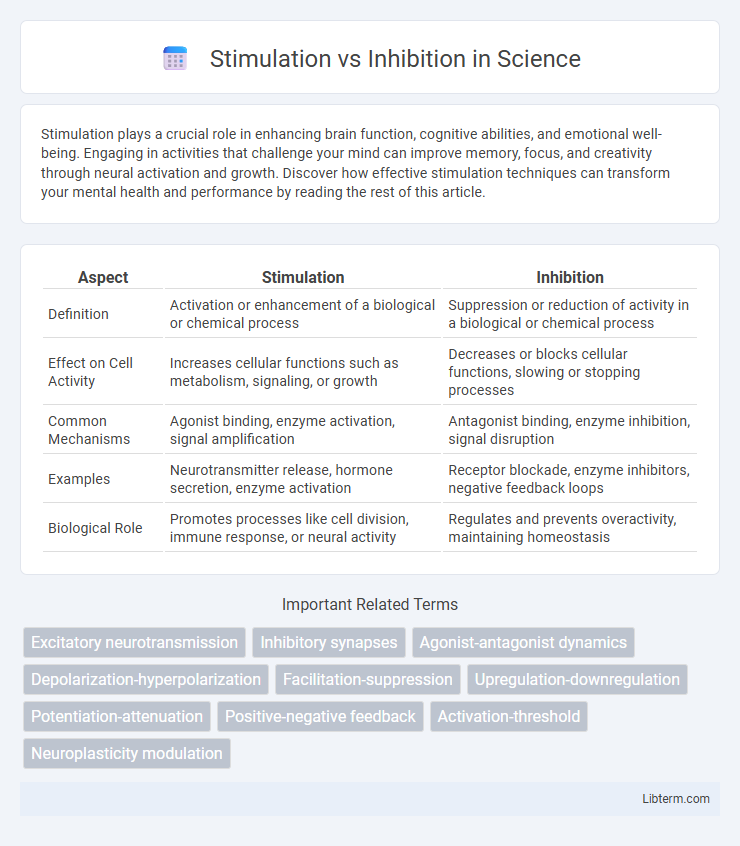Stimulation plays a crucial role in enhancing brain function, cognitive abilities, and emotional well-being. Engaging in activities that challenge your mind can improve memory, focus, and creativity through neural activation and growth. Discover how effective stimulation techniques can transform your mental health and performance by reading the rest of this article.
Table of Comparison
| Aspect | Stimulation | Inhibition |
|---|---|---|
| Definition | Activation or enhancement of a biological or chemical process | Suppression or reduction of activity in a biological or chemical process |
| Effect on Cell Activity | Increases cellular functions such as metabolism, signaling, or growth | Decreases or blocks cellular functions, slowing or stopping processes |
| Common Mechanisms | Agonist binding, enzyme activation, signal amplification | Antagonist binding, enzyme inhibition, signal disruption |
| Examples | Neurotransmitter release, hormone secretion, enzyme activation | Receptor blockade, enzyme inhibitors, negative feedback loops |
| Biological Role | Promotes processes like cell division, immune response, or neural activity | Regulates and prevents overactivity, maintaining homeostasis |
Introduction to Stimulation and Inhibition
Stimulation and inhibition are fundamental physiological processes that regulate cellular and neural activity. Stimulation enhances activity by increasing the likelihood of action potentials or biochemical responses, often through excitatory neurotransmitters like glutamate. Inhibition suppresses activity by decreasing excitability, commonly mediated by inhibitory neurotransmitters such as gamma-aminobutyric acid (GABA), maintaining balance and preventing overactivation in biological systems.
Defining Stimulation: Concepts and Mechanisms
Stimulation refers to the process by which a biological or neural system is activated or enhanced through various external or internal signals, leading to increased activity or response. Mechanisms of stimulation often involve the binding of neurotransmitters or hormones to specific receptors, triggering cascades of intracellular events such as ion channel opening or second messenger activation. This activation promotes cellular functions like increased neurotransmission, muscle contraction, or metabolic activity, distinguishing stimulation from inhibition, which suppresses these processes.
Understanding Inhibition: Key Principles
Inhibition is a fundamental neural process that regulates and suppresses neuronal activity to maintain balance within the nervous system. Key principles of inhibition include selective suppression of excitatory signals, modulation through neurotransmitters like GABA, and its critical role in preventing overstimulation and enhancing signal precision. Effective inhibitory mechanisms are essential for processes such as sensory filtering, motor control, and cognitive function.
Biological Foundations of Stimulation and Inhibition
Neural stimulation involves the activation of neurons through excitatory neurotransmitters like glutamate, which increases the likelihood of action potentials by depolarizing the postsynaptic membrane. In contrast, neural inhibition is mediated primarily by inhibitory neurotransmitters such as gamma-aminobutyric acid (GABA), which hyperpolarizes the membrane and reduces neuronal firing. These mechanisms are fundamental for maintaining the balance of neural circuits, enabling precise control of physiological processes and preventing disorders like epilepsy.
Neurotransmitters: Balancing Excitation and Suppression
Neurotransmitters play a crucial role in balancing stimulation and inhibition within the nervous system by modulating synaptic transmission. Excitatory neurotransmitters like glutamate increase neuronal activity by promoting the influx of positive ions, while inhibitory neurotransmitters such as gamma-aminobutyric acid (GABA) reduce activity by enhancing chloride ion influx or potassium ion efflux. This dynamic equilibrium between excitatory and inhibitory signals ensures proper neural circuit function, preventing excessive excitation that can lead to excitotoxicity or insufficient activation that impairs cognitive and motor processes.
Stimulation vs Inhibition in Brain Function
Stimulation in brain function enhances neural activity by increasing the firing rates of neurons and promoting synaptic plasticity, which improves learning, memory, and cognitive processing. In contrast, inhibition reduces neuronal excitability through mechanisms such as GABAergic signaling, maintaining neural circuit stability and preventing overactivation that can lead to disorders like epilepsy. The dynamic balance between stimulation and inhibition is critical for optimal brain function, supporting processes such as sensory integration, motor control, and emotional regulation.
Impact on Mental Health and Behavior
Stimulation enhances neural activity, leading to increased alertness, motivation, and cognitive function, which can improve mood and reduce symptoms of depression and anxiety. Inhibition regulates neural circuits by suppressing excessive or unwanted responses, promoting emotional stability and preventing impulsive behaviors associated with disorders like ADHD and bipolar disorder. Imbalances between stimulation and inhibition in brain regions such as the prefrontal cortex and amygdala significantly influence mental health outcomes and behavioral patterns.
Pharmacological Modulation: Drugs Affecting Stimulation and Inhibition
Pharmacological modulation involves drugs that alter neural activity by affecting stimulation and inhibition mechanisms at synapses. Stimulatory drugs, such as amphetamines, enhance neurotransmitter release or receptor activation, increasing excitatory signaling within the central nervous system. In contrast, inhibitory drugs like benzodiazepines potentiate gamma-aminobutyric acid (GABA) receptor function, augmenting inhibitory neurotransmission and promoting neural suppression.
Therapeutic Applications and Clinical Implications
Stimulation and inhibition therapies play crucial roles in treating neurological and psychiatric disorders by modulating neural circuit activity to restore functional balance. Deep brain stimulation (DBS) is widely used in Parkinson's disease and essential tremor to enhance motor control through targeted electrical stimulation, while inhibitory techniques like transcranial magnetic stimulation (TMS) effectively reduce hyperactivity in conditions such as depression and epilepsy. Understanding the differential mechanisms and clinical outcomes of excitation versus suppression therapies informs personalized treatment strategies, optimizing efficacy and minimizing adverse effects in diverse patient populations.
Future Research and Innovations in Stimulation-Inhibition Dynamics
Future research in stimulation-inhibition dynamics is poised to leverage advanced neuroimaging techniques and machine learning models to unravel complex brain network interactions at unprecedented resolutions. Innovations in optogenetics and neuromodulation hold promise for precise control of neural excitability, enabling targeted therapeutic interventions for neurological disorders such as epilepsy and Parkinson's disease. Exploration of biofeedback-integrated stimulation systems aims to create adaptive, real-time modulation frameworks that optimize cognitive and motor functions through dynamic balance of excitation and inhibition processes.
Stimulation Infographic

 libterm.com
libterm.com